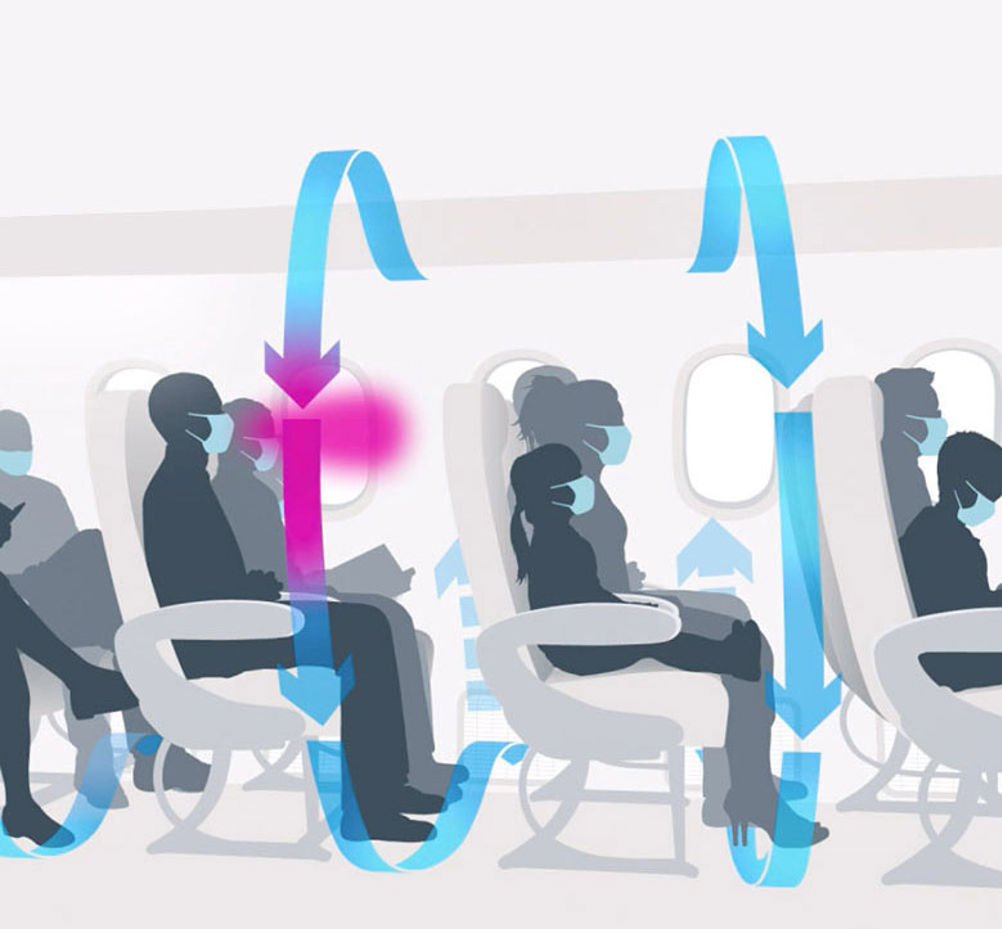Unsurprisingly, large numbers of passengers in a confined space aboard an airplane mean high concentrations of dust, fibers, bacteria and other microorganisms, all of which can pose a risk to occupants.
Hence the need for High Efficiency Particulate Air (HEPA) filters which are universally fitted to aircraft ventilation having been introduced in the 1980s. So how do they work in this context?
According to manufacturer Boeing, at 36,000 feet outside air (known as engine bleed air) continuously enters the airplane, either through the engines or, in the case of the 787, through electric compressor inlets. At this altitude, air is very clean, dry, low in oxygen and practically particulate-free.
The air is compressed and then travels to the air conditioning packs, where it is conditioned to the appropriate pressure and temperature. It goes into a mix manifold where it is mixed in an approximately 50:50 ratio with filtered cabin air.
High efficiency
Boeing airplanes use high efficiency particulate air (HEPA) filters that remove more than 99.9% of particulates such as bacteria and viruses from the air before it is recirculated to the cabin.
The mix of outside and filtered air is then supplied through an overhead network that runs the length of the cabin. This air circulates before leaving through return air grilles that also run the length of the cabin.
Cabin air flows primarily from ceiling to floor, not front to back, in a circular pattern and leaves through the floor grilles near the same seat row where it enters, minimizing the potential spread of contaminants.
About 50% of air that leaves the cabin is exhausted from the airplane, while the other 50% passes through a HEPA filter before entering the mix manifold, where it is mixed with outside air before being resupplied to the cabin. The volume of cabin air is exchanged every two to three minutes.
Compare that to the air in hospitals which is fully renewed every 10 minutes and in office buildings which is renewed every 20 minutes on average.
Detailed simulations
Bruno Fargeon, leader of the Airbus Keep Trust in Air Travel Initiative, said: “After multiple, highly detailed simulations using the most accurate scientific methods available, we have concrete data which reveals the aircraft cabin offers a much safer environment than indoor public spaces.
“The way that air circulates, is filtered and replaced on airplanes creates a unique environment in which you have just as much protection being seated side-byside as you would standing six feet apart on the ground.”
Cabin air filters remove particles using three primary methods. With direct interception, particles are larger than the pore sizes which makes them unable to penetrate the medium. Inertial impaction involves particles hitting the surfaces of the pores formed by the fibers of the filter medium where they adhere and are captured. This mechanism removes particles in the 0.3μ to 10μ range depending on the filtration rating of the filter medium.
The smallest particles are picked up by diffusional interception. Brownian motion results in rapid random movements about a nominal trajectory which causes the particles to come into contact with and to be collected on, the fibers and pore walls of the filter medium. This mechanism is effective for particles below about 0.2μ. Significantly, the smaller the particle, the greater the Brownian motion and the higher the capture efficiency.
Contamination analytics
Airplane filter manufacturer Pall Aerospace has taken the filtration process one step further with its Purecabin technology. This not only filters the cabin air but also the engine bleed air which can contain volatile organic compounds (VOCs) such as engine oil or deicing fluid that create unpleasant odors and, in some cases, become harmful.
The system also offers real-time contamination analytics for improved operational efficiency.
Pall Aerospace reached an agreement with low-cost European airline easyJet to retrofit its fleet of Boeing A320 aircraft with its Advanced Cabin Air Filters which also use carbon to help remove odors and VOCs.
Ian Davies, head of engineering at easyJet, said: “Aircraft cabin odor events can lead to expensive delays or air turn backs and the Pall odor filters are helping us mitigate that issue.”
Boeing recommends filters are replaced at regularly scheduled maintenance intervals, typically once every 12 to 18 months. It claims HEPA filters become more effective with time as the particulates on the surface provide additional filtration with increased surface area.
Of course, when Covid-19 struck, the airline industry came under particular scrutiny prompting Airbus, Boeing and Embraer to carry out separate computational fluid dynamics (CFD) research studies.
While there is little that can be done about a passenger sneezing next to you, each detailed simulation confirmed that aircraft airflow systems do control the movement of particles in the cabin, limiting the spread of viruses. This was backed up by a report from the European Centre for Disease Control (ECDC) which stated air passengers should not be considered high risk for spreading Covid-19.

Cabin design
Live cough modeling tests found that the cabin design and airflow system quickly and effectively remove particulates from the air.
The ECDC said: “Based on the latest scientific evidence and information, the document’s conclusions reflect the fact that the prevalence of the coronavirus among travellers is estimated to be lower than is the case for the general population. In addition, the measures in place in aviation minimise the possibility of transmission during air travel.”
Naturally, aircraft manufacturers and airlines are keen to emphasize the safety of their cabins in the post-pandemic era but it seems there is little truth in the assumption that air travel carries a higher risk of Covid-19 transmission.
As Peter O’Neill, chief operations officer at Irish airline Aer Lingus, said: “Thanks to the air filtration systems on board all of our aircraft and how air flow is managed, it has been proven that the only other indoor environment with comparable air quality is an operating theatre.”





